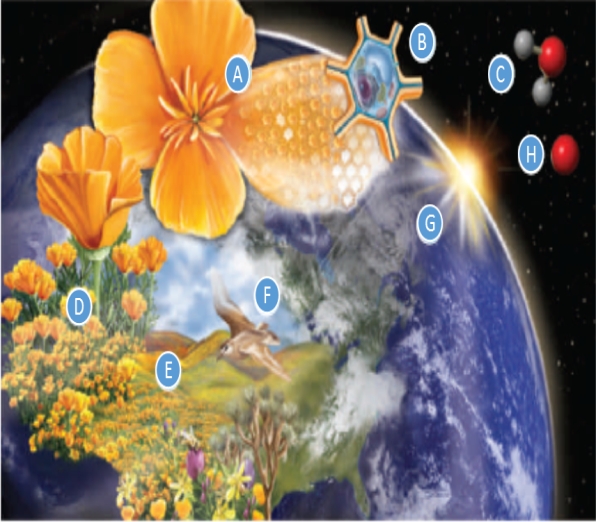A) Observation
B) Hypothesis
C) Prediction
D) Experiment
E) Control group
F) Experimental group
G) The variable
H) Results
I) Conclusion
Correct Answer

verified
Correct Answer
verified
Multiple Choice
Which of the following characteristics are shared by all living organisms? I.hereditary information is passed to offspring II.adaptation to environmental change III.requirement for nutrients IV.DNA housed in a nucleus
A) I and II
B) I and III
C) II and III
D) I, II, and III
E) I, II, III, and IV
Correct Answer

verified
Correct Answer
verified
Short Answer
Match the term with its definition.  -Group of interbreeding individuals of the same species that live in a given area
-Group of interbreeding individuals of the same species that live in a given area
Correct Answer

verified
Correct Answer
verified
Multiple Choice
A substance that an organism needs for growth and survival but cannot make for itself is referred to as a(n) ____.
A) chemical
B) nutrient
C) atom
D) DNA molecule
E) carbohydrate
Correct Answer

verified
Correct Answer
verified
Multiple Choice
The final step in the scientific method for a scientist is ____.
A) devising an experiment
B) collecting data
C) making observations
D) report his or her results
E) researching the literature for similar investigations
Correct Answer

verified
Correct Answer
verified
Multiple Choice
Why do scientists typically design experiments that will yield quantitative results?
A) Scientists are unable to perform qualitative studies.
B) Quantitative results minimize the potential for bias.
C) To prevent other scientists from repeating their experiments.
D) Scientists cannot always observe all individuals of a group.
E) Quantitative results increase desirable bias.
Correct Answer

verified
Correct Answer
verified
Multiple Choice
Which of the following represents the most correct order of the organization of life from the smallest unit to the largest?
A) atoms-> molecules-> cells-> organisms-> populations-> communities-> ecosystems-> biosphere
B) atoms-> molecules-> cells-> organisms-> communities -> populations ecosystems-> biosphere
C) atoms-> molecules-> cells-> organisms-> populations-> ecosystems-> communities-> biosphere
D) communities-> biosphere-> organisms-> ecosystems-> populations-> cells-> molecules-> atoms
E) biosphere-> organisms-> communities-> ecosystems-> populations-> molecules-> cells-> atoms
Correct Answer

verified
Correct Answer
verified
Multiple Choice
An ecosystem is made up of ____.
A) only plants, animals and fungi
B) organisms and nonliving things
C) only rocks and minerals
D) only plants, protozoa, and fungi
E) the biosphere of the region
Correct Answer

verified
Correct Answer
verified
Multiple Choice
In 1610,which scientist was imprisoned for publishing evidence that the Earth orbits the sun?
A) Aristotle
B) Copernicus
C) Galileo
D) Darwin
E) Newton
Correct Answer

verified
Correct Answer
verified
Multiple Choice
Classification. Answer the following questions in reference to life's diversity. Choose only the most correct answer. -They have no nucleus and are the most numerous organisms on Earth.
A) archaea
B) bacteria
C) Eukarya
D) Plantae
E) fungi
F) Animals
G) Protists
Correct Answer

verified
Correct Answer
verified
Multiple Choice
Based on the Olestra potato chip experiment conducted by researchers at the Johns Hopkins University School of Medicine, match the following letters to the number with which they best correspond. -In the control group,17.6% of people reported having cramps later,while in the experimental group,15.8% of people had cramps later.
A) Observation
B) Hypothesis
C) Prediction
D) Experiment
E) Control group
F) Experimental group
G) The variable
H) Results
I) Conclusion
Correct Answer

verified
Correct Answer
verified
Multiple Choice
All known species belong to one of three domains.What are these domains?
A) Prokarya, Bacteria, and Eukarya
B) Prokarya, Archaea, and Eukarya
C) Plantae, Bacteria, and Animalia
D) Bacteria, Archaea, and Eukarya
E) Bacteria, Archaea, and Protista
Correct Answer

verified
Correct Answer
verified
Multiple Choice
The category of organisms that get their energy and nutrients by feeding on the tissues,wastes,or remains of other organisms are generally called ____.
A) producers
B) prokaryotes
C) consumers
D) archaea
E) plants
Correct Answer

verified
Correct Answer
verified
Multiple Choice
In the Olestra experiment conducted by researchers at the Johns Hopkins University School of Medicine,the people who ate the Olestra potato chips were the ____.
A) experimental group
B) control group
C) research group
D) hypothetical group
E) independent group
Correct Answer

verified
Correct Answer
verified
Multiple Choice
Energy flow is one-way because ____.
A) all of the energy in an ecosystem stays constant
B) the amount of energy a producer harvests is equal to the amount of energy consumers consume
C) with each energy transfer, some energy escapes as heat
D) energy cannot be created but it can be destroyed
E) there is only one form of energy
Correct Answer

verified
Correct Answer
verified
Multiple Choice
In the 2005 peacock butterfly experiment,what was the conclusion?
A) Predatory birds are not deterred from eating peacock butterflies with spots.
B) Predatory birds are deterred by peacock butterfly clicking sounds.
C) Peacock butterflies with spots mated more often than those without spots.
D) Predatory birds are deterred by the dark color of the peacock butterfly.
E) Peacock butterflies that made clicking sounds attracted more predatory birds.
Correct Answer

verified
Correct Answer
verified
Multiple Choice
Classification. Answer the following questions in reference to life's diversity. Choose only the most correct answer. -This single-celled or multicelled eukaryotic consumer breaks down material outside itself,then absorbs nutrients released from the breakdown.
A) archaea
B) bacteria
C) Eukarya
D) Plantae
E) fungi
F) Animals
G) Protists
Correct Answer

verified
Correct Answer
verified
Multiple Choice
The current rate of extinctions is about ____ times faster than normal.
A) 10
B) 100
C) 1000
D) 100,000
E) 1,000,000
Correct Answer

verified
Correct Answer
verified
Short Answer
Match the term with its definition.  -All populations of all species in a given area
-All populations of all species in a given area
Correct Answer

verified
Correct Answer
verified
Multiple Choice
In science,all results ____.
A) are accepted as fact
B) are only hypotheses
C) have a probability of being incorrect
D) must be consistent with previous knowledge
E) are uncritically accepted by other scientists
Correct Answer

verified
Correct Answer
verified
Showing 81 - 100 of 100
Related Exams